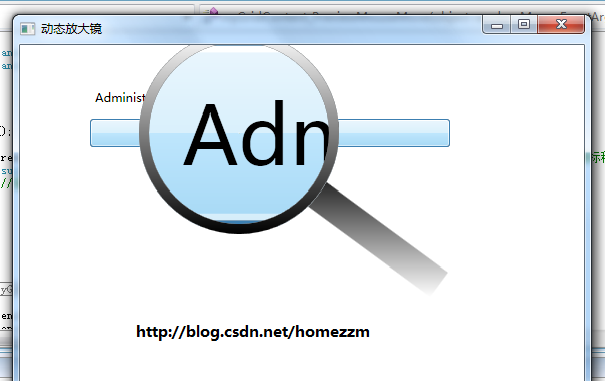最终效果如图:

后台代码如下:
/// <summary>
/// Window6.xaml 的交互逻辑
/// </summary>
public partial class Window6 : Window
{
Grid myGrid = new Grid();
Grid myGd = new Grid();
Canvas canvasOne = new Canvas();
Canvas canvasTwo = new Canvas() { Name = "myCanvas" };
Path pathTwo = null;
public Window6()
{
InitializeComponent();
Init(); //初始化控件
this.myGridContent.PreviewMouseMove += new MouseEventHandler(myGridContent_PreviewMouseMove);
//为最外层的Grid添加鼠标移动事件
VisualBrush vb = (VisualBrush)pathTwo.Fill;
vb.Visual = myGd; //指定加载时显示的放大区域
}
//初始化控件
void Init()
{
#region 放大镜区域-Grid
//线
Line line = new Line()
{
X1 = 150,
Y1 = 140,
X2 = 300,
Y2 = 250,
StrokeThickness = 30,
Stroke = new LinearGradientBrush() //使用线性渐变绘制区域
{
StartPoint = new Point(0, 0), //开始位置
EndPoint = new Point(0, 1), //结束位置
GradientStops = new GradientStopCollection() //渐变的颜色
{
new GradientStop(Colors.White,1),
new GradientStop(Colors.Black,0)
}
}
};
//路径-1
Path pathOne = new Path()
{
Fill = new SolidColorBrush(Colors.White),
Width = 200,
Height = 200,
Data = new GeometryGroup()
{
Children = new GeometryCollection()
{
new EllipseGeometry(new Point(100,100),100,100), //从中心开始,画一个圆,半径是100
new EllipseGeometry(new Point(100,100),1,1) //从中心开始,画一个小圆,半径是1
}
}
};
//路径-2
pathTwo = new Path()
{
Name = "myPath",
Width = 200,
Height = 200,
Fill = new VisualBrush()
{
Viewbox = new Rect(0, 0, 30, 30),
ViewboxUnits = BrushMappingMode.Absolute,
Viewport = new Rect(0, 0, 1, 1),
ViewportUnits = BrushMappingMode.RelativeToBoundingBox
},
Data = new GeometryGroup()
{
Children = new GeometryCollection()
{
new EllipseGeometry(new Point(100,100),100,100), //从中心开始,画一个圆,半径是100
new EllipseGeometry(new Point(100,100),1,1) //从中心开始,画一个小圆,半径是1
}
}
};
//圆-1
Ellipse ellipseOne = new Ellipse()
{
Width = 200,
Height = 200,
StrokeThickness = 10,
Stroke = new LinearGradientBrush()
{
StartPoint = new Point(0, 0),
EndPoint = new Point(0, 1),
GradientStops = new GradientStopCollection()
{
new GradientStop(Colors.Black,0),
new GradientStop(Colors.White,1)
}
}
};
//圆-2
Ellipse ellipseTwo = new Ellipse()
{
Width = 200,
Height = 200,
StrokeThickness = 10,
Stroke = new LinearGradientBrush()
{
StartPoint = new Point(0, 0),
EndPoint = new Point(0, 1),
GradientStops = new GradientStopCollection()
{
new GradientStop(Colors.Black,1),
new GradientStop(Colors.White,0)
}
}
};
myGrid.Children.Add(canvasOne);
canvasOne.Children.Add(canvasTwo);
canvasTwo.Children.Add(line);
canvasTwo.Children.Add(pathOne);
canvasTwo.Children.Add(pathTwo);
canvasTwo.Children.Add(ellipseOne);
canvasTwo.Children.Add(ellipseTwo);
#endregion
#region 需要放大的内容区域-myGd
Button btn = new Button()
{
Margin = new Thickness(70, 73, 134, 0),
Height = 28,
Content = "Administrator",
VerticalAlignment = VerticalAlignment.Top
};
Label lbl = new Label()
{
Margin = new Thickness(70, 39, 88, 0),
Height = 28,
Content = "Administrator",
VerticalAlignment = VerticalAlignment.Top
};
myGd.Children.Add(btn);
myGd.Children.Add(lbl);
#endregion
myGridContent.Children.Add(myGd);
myGridContent.Children.Add(myGrid);
}
void myGridContent_PreviewMouseMove(object sender, MouseEventArgs e)
{
VisualBrush vb = (VisualBrush)pathTwo.Fill;
Point point = e.MouseDevice.GetPosition(myGd);
Rect rc = vb.Viewbox;
rc.X = point.X - rc.Width / 2;
rc.Y = point.Y - rc.Height / 2;
vb.Viewbox = rc;
Canvas.SetLeft(canvasTwo, point.X - pathTwo.Width / 2);
Canvas.SetTop(canvasTwo, point.Y - pathTwo.Height / 2);
}
}






















 407
407

 被折叠的 条评论
为什么被折叠?
被折叠的 条评论
为什么被折叠?








